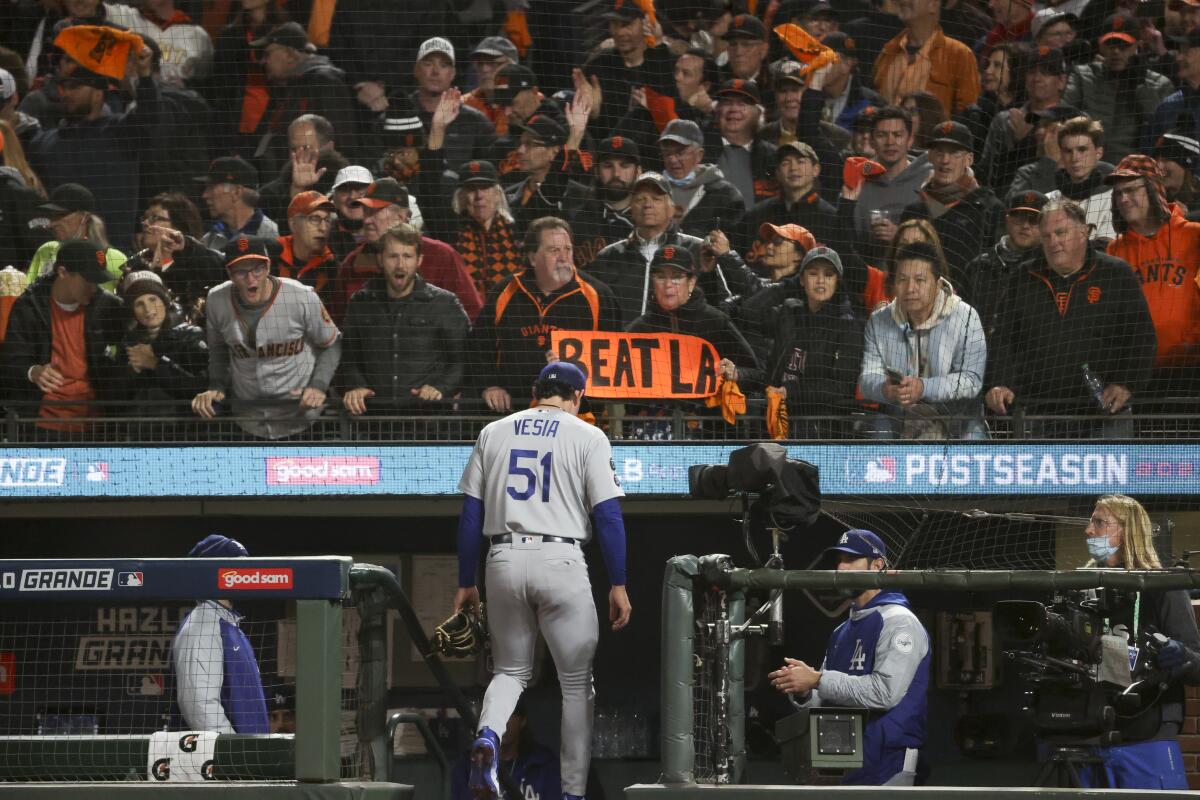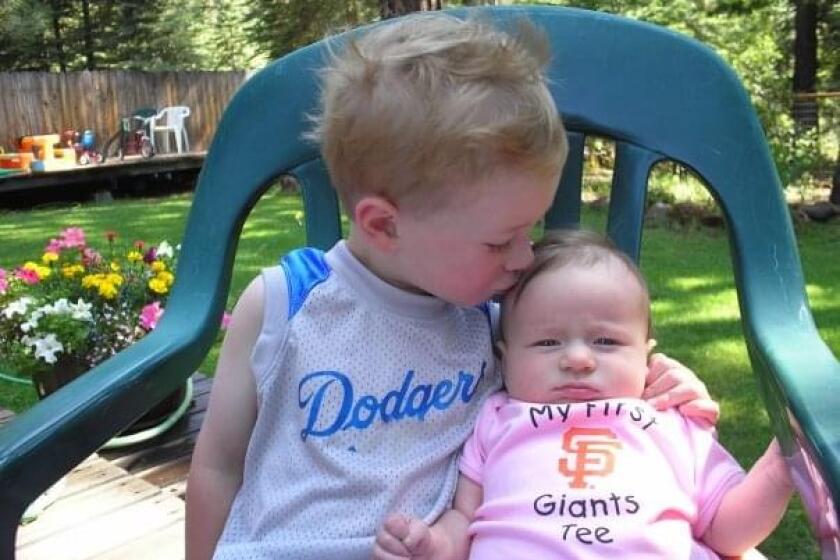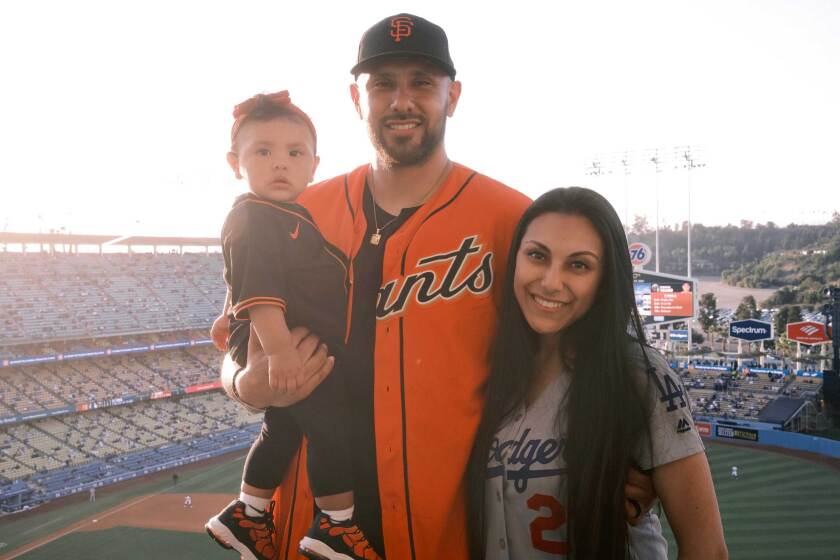In search of a California dividing line, where Giantslandia starts and Dodgersville ends

- Share via
CAMBRIA, Calif. — You know you’ve come to the right place when you walk in the door of the West End Bar & Grill on a night that will go down in baseball history.
Co-owner Gary Neal, wearing a San Francisco Giants jersey with a “world champions” patch on the sleeve, works the door. Mark Glanzman, the guy in the Dodger-blue shirt with “Kersh” for pitcher Clayton Kershaw emblazoned on the back, holds down the center of the bar.
You are 233 miles south of Oracle Park, where the Giants hold court, 236 miles north of Dodger Stadium. The game — the first postseason duel in the fervent rivals’ century-plus history — is about to begin on four of the sports bar’s five television sets. No one’s watching TV No. 5, where the Lakers lose to the Golden State Warriors.
You’ve been searching for the not-so-imaginary line where Giants love gives way to Dodgers mania, a place of baseball equilibrium.
“You’re here,” Neal says Friday night.

As boundaries go, the dividing line between blue California and its orange-and-black counterpart is less distinct than the Mason-Dixon line or the 38th parallel. It’s harder to find than a brisk exit from the Dodger Stadium parking lot, more elusive than a National Baseball Hall of Fame berth for Barry Bonds.
“Determining geographically, with any precision, where one team’s fan base stops and another begins, can be a little like trying to determine where the peanut butter stops and the jelly begins,” said USC sports economist David Carter. “You know it at the margins, but beyond that, it gets tricky.”
It’s particularly hard with teams like these two, which had their starts nearly 3,000 miles away in the late 1800s. They have storied histories and national followings, which means they have fans, well, everywhere.
Geography is one factor in determining the boundaries of a baseball-fan map. So are broadcast rights and Major League Baseball’s territorial restrictions on team marketing efforts. The team your dad liked can determine your allegiance; so can the first ball field your mom took you to.
“My hunch is that we are looking at fans being more dug in for one team or the other to the northern (orange)/southern (blue) part of the state,” Carter said in an email, “with central California a mixture of the two (brown).”
If you start your search for the Giants-Dodgers dividing line in deep-blue Southern California, head north on the 101 Freeway. Once you hit Gaviota or so, the glittering Pacific will be on your left, coastal California’s trademark golden hills, craggy oaks and lush agricultural fields on your right.
Santa Maria, about 160 miles north, is still solid Dodger blue, whether you look at the map SeatGeek.com put together in 2019, the one the New York Times created in 2014, or you ask the barista at Coffee Time on Betteravia Road.
We asked readers who live in a divided house to tell us how they’re coping with the Dodgers or Giants fan in their life.
Her name’s Carina Alonso. She is 18. She owns a Dodgers hat, a Dodgers T-shirt and a Dodgers jersey. Even though she’s not much of a baseball fan.
“They’re a great team, and I love their colors,” Alonso says as she pulls espresso shots. “I see a lot of people in this town wearing their shirts and their hats. If they had to pick a team, it’d be the Dodgers.”
Hang a left at Templeton and stop when you hit Cambria, population 6,000 or so. This is the start of what USC’s Carter describes as California’s thin brown line, where there are around as many Giants fans as there are Dodgers fans.
“It’s quite a rivalry in town,” says Kimberly Maston, owner of Cambria Homes & Land and the town’s honorary mayor. Maston grew up in Camarillo, where she’d come home from school and watch the Dodgers on television, where she said she “never met a Giants fan.”
Maston and her husband, Robert, attended a 70th birthday party Thursday night. A friend — a die-hard Giants fan — was waiting for her boyfriend to pick her up from the event. He arrived in a car flying a Dodgers flag.
“She said, ‘I’m not getting in that car until you take that flag down,’” Robert Maston recounted.
At the West End Bar & Grill on Friday night, five Giants fans sit at the bar. And five Dodgers fans. Giants catcher Buster Posey smashes a two-run homer at the end of the first inning, and half the place goes wild.
“The truth of the matter is,” Neal says, “I love my Dodgers fans as much as I love my Giants fans.”
Then he regales Glanzman with a baseball joke that’s more wishful thinking than statistical accuracy, given the Dodgers’ 2020 World Series championship:
“You know the difference between a San Francisco bratwurst and a Dodger Dog?” Neal asks. “You can’t get a Dodger Dog in October.”
Ba-dum-bum.
The NLDS between the Dodgers and the Giants, the first postseason series between the bitter rivals, will divide the state and households alike.
Glanzman is a retired contract administrator who grew up in Los Angeles. His face gets wistful when he talks about how he came to be a Dodgers fan. He went to his first game at Chavez Ravine in 1962. He says he remembers it “like it was yesterday, the cut grass.”
“You stay with your allegiance,” he says. “If I moved to New Jersey or New Mexico, I’d never change teams. It was forged when I was 6.”
Lu Estrada, four stools to Glanzman’s right, went to his first Giants game in 1964, at frigid Candlestick Park.
“I was hooked forever,” says Estrada, who owns a water truck and just got back from working the Dixie fire. “Willie Mays was in center field, and I was hooked forever. The next day and every day on, I ran out to the front porch and got the paper and read the box score over breakfast.”
Giants shortstop Brandon Crawford hits a solo home run in the eighth inning, and the West End erupts with a mix of joy and dismay. Estrada, in a Giants cap and black-and-orange plaid shirt, lets out a whoop.
Deborah Patchen — Glanzman’s partner, owner of Antiques on Main and a lifelong Dodgers fan — whispers, “Bad, bad, bad. Oh, my God.”
The Giants win that first game 4-0. Saturday morning, Glanzman is out in front of Cambria Coffee Roasting Co., wearing a Dodgers jacket and sipping coffee. There’s a sign in the window: “Reserved Parking SF Giants Fans Only.”
“Yeah,” says one of Glanzman’s pals, “but they’ll serve coffee to anyone.”
A quest for the Giants-Dodgers dividing line reveals as much about California as it does about the national pastime.
It arcs from seaside Cambria northeast through Paso Robles wine country, all tasting rooms and vine-filled acres. Highway 46 is the kind of road that makes you want to stop and snap a photograph after every curve. It hits Highway 41 at the James Dean Memorial Junction near Shandon, and the vistas become a different kind of beautiful, the occasional line of green trees striping a tan landscape.
Kettleman City, population about 1,100, is just east of Interstate 5. It is dusty and spare, bordered by orchards and the California Aqueduct. Kettleman City Market has a shelf lined with ballcaps. There are Raiders caps and Niners caps, black hats embroidered “Michoacan” and “Jalisco.”
The store sells Giants caps too. There is not a Dodgers cap in sight.
But at the Mi Ranchito restaurant tucked inside the market, owner Sandra Bravo talks about her small town’s baseball ambivalence.
“It’s half and half here,” she says, as she cooks beneath a sign that offers tacos and flautas, burritos and shrimp. “I have cousins who even go to L.A. for the games. I also have a lot of friends who go for the Giants.”
The clash between baseball rivals reflects a broader competition between north and south.
By the time the boundary ends in the ag towns of Tulare County, where farmers joke that there are more cows than people, there are fewer fans to pledge any kind of allegiance.
But they do.
Sam Sigal is president and owner of the Visalia Rawhide, a minor league team in the Tulare County seat. He’s originally from San Francisco, a Giants fan since he was 6 years old and saw Barry Bonds play at Candlestick Park.
On Friday night, he held a watch party for the first game of the National League Division Series and got audio proof of just how evenly split his region and his party guests are in their baseball allegiance.
At one point, he said, he stepped out to take a phone call. The party erupted in cheers. Were the Giants fans whooping for a big double play started by Tommy La Stella? Or were the Dodgers fans applauding their team’s heroics?
“I didn’t know, as a Giants fan, if I would be happy or not,” he said. “There was no way to know. It showed just how split it is.”
Come Saturday night, there was no doubt who was doing most of the cheering. The Dodgers offense woke up, and the Boys in Blue blasted the Giants 9-2.
The tie in the best-of-five series will be broken Monday in a pivotal Game 3.
But in these parts of California, it’s a safe bet that loyalties will forever remain a tie game.
More to Read
Sign up for Essential California
The most important California stories and recommendations in your inbox every morning.
You may occasionally receive promotional content from the Los Angeles Times.














